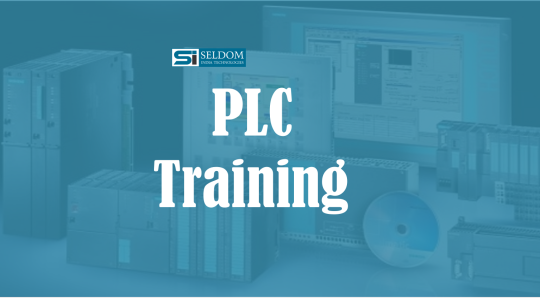#PLC SCADA training
Explore tagged Tumblr posts
Text
AVEVA Wonderware System Platform
youtube
🌐Website :- https://asteamtechno.com
👉Contact us :- +91 95372 40404
📧Email :- [email protected]
#AVEVA#automation#trending#tumblr trends#viral#bestdeals#viralpost#trendingnow#plc#plc scada training#scada#scada software#scada systems#tech#technology#industrial automation#industry#industrial#electronic#Youtube
1 note
·
View note
Text
PLC SCADA Training - Expert Automation Training
Seldom India's PLC SCADA training program is designed to equip students with essential skills in industrial automation. Our expert trainers provide hands-on experience in programming and managing Programmable Logic Controllers (PLC) and Supervisory Control and Data Acquisition (SCADA) systems. With a focus on practical applications, our PLC SCADA training covers everything from basic automation techniques to advanced industrial controls. Students will work on real-world projects and receive guidance tailored to their individual learning goals. Located in Jaipur, Seldom India is committed to delivering top-notch PLC SCADA training to help you advance in your automation career.

1 note
·
View note
Text
VIATA facilitates a comprehensive ''Theoretical as well as Practical (on-hand, on-job) Training'' on Automation Technologies, PLC SCADA Courses in Nashik, and SCADA training to its students, situated at the heart of Nashik city.
Only Automation Training Institute in Nashik, Providing Training on Stepper & Servo Motors and its drive technologies, Providing DCS & IIoT Training. Our objective is to provide Practical Work Exposure to our students to gain ‘Lifetime confidence’.
0 notes
Text
#BD Engineering#BD Engineering Solution#industrial automation#industrial engineering#industrial equipment#plc scada training#plc#hmi#vfd
0 notes
Text
What are the main advantages of PLC?
Programmable Logic Controllers (PLCs) have become a staple in the modern industrial landscape. They offer a multitude of advantages that make them essential for efficient and reliable operations. PLCs provide a platform for automating processes and minimising human errors. They are also used to optimise processes, making them a valuable asset for many industries. PLCs form an integral part of training curricula provided by corporate training entities and PLC SCADA training institutes. These institutes specialise in industrial automation and provide essential knowledge for the successful implementation of PLCs in any industry. This article highlights the primary advantages of PLCs and their importance in the realm of industrial automation. They are a cornerstone of industrial progress, helping equip personnel with the necessary skills and knowledge to tackle the challenges of the modern industrial landscape.
Reliability and Durability: PLCs are created to work in tough industrial environments. They are resilient against extreme temperatures, humidity and vibrations, ensuring optimal performance and minimal downtime. Their reliability is critical in industries requiring continuous operations.
High-Speed Processing: PLCs are renowned for their fast processing, enabling quick and accurate control of industrial processes. Their speed is essential for industries requiring real-time responsiveness.
Flexibility and Adaptability: PLCs offer excellent adaptability to meet different automation needs. Reprogramming or adjusting them to fit changes in production processes is simple and requires minimal hardware changes, helping industries stay agile and ready for new challenges.
Cost-Effectiveness:PLCs are a cost-effective alternative to bespoke control systems. No wiring or custom hardware is needed, reducing setup and maintenance costs.
Remote Monitoring and Control: PLCs enable efficient remote surveillance and management of industrial processes when integrated with SCADA systems. This lowers the need for on-site personnel, and facilitates efficient oversight and troubleshooting.
Enhanced Safety: PLCs help create safer workplaces by reducing the risk of human errors. They can set safety protocols, trigger emergency shut downs, and monitor for faults, ensuring the safety of employees.
Data Logging and Analysis: PLCs are used to collect and store data from sensors and devices. This data can then be analysed to identify trends, optimise processes and anticipate maintenance. All of this leads to improved efficiency and less downtime.
Streamlined Troubleshooting: PLCs are very useful for maintenance personnel as they give comprehensive diagnostics and error messages to quickly identify and fix issues, minimising production disruptions.
Energy Efficiency: PLCs can be programmed to save energy by efficiently regulating equipment and processes. This can help reduce overall energy costs and reduce environmental impact.
Scalability: Industries need to automate more processes as they expand and develop. PLC systems are great for this because they can easily be scaled to accommodate more input/output points and complexity, without causing too much disruption.
PLCs (Programmable Logic Controllers) have become the foundation of industrial automation, offering numerous benefits that significantly increase productivity, safety, and cost-efficiency in a variety of industries. To gain the most from PLCs and other automation technologies, specialized training programs offered by PLC SCADA training institutes such as DIAC in Noida. These programs provide individuals with the knowledge and skills to maximize the use of PLCs and related technologies, enabling them to become key players in the automation revolution taking place in today's industries.
0 notes
Text
نقش پی ال سی در کاهش هزینه ه
۱. کاهش هزینه نصب و راهاندازی: پی ال سی ها اغلب بهعنوان جایگزین مناسبی برای سیستمهای کنترل مکانیکی و الکترومکانیکی سنتی مورد استفاده قرار میگیرند. نصب و راهاندازی PLCها معمولاً سریعتر و آسانتر از راهاندازی سیستمهای سنتی است و نیاز به تعویض و تغییرات کمتری دارد، که منجر به کاهش هزینههای نصب و راهاندازی میشود.
۲. افزایش بهرهوری: PLCها امکاناتی را برای برنامهریزی و کنترل دقیق فرآیندها و تجهیزات فراهم میکنند. با استفاده از PLCها، میتوان بهبودهایی در عملکرد و بهرهوری فرآیندها و تجهیزات داشت. به عنوان مثال، با اجرای برنامههای کنترلی پیچیده و دقیق، میتوان مصرف انرژی را بهینه کرده و هدررفت انرژی را کاهش داد. این منجر به صرفهجویی در هزینههای انرژی میشود. نقش پی ال سی در هوشمندسازی ساختمان را بدانید، بهتر است.
۳. کاهش هزینه تعمیر و نگهداری: پی ال سی ها به دلیل طراحیهای ماژولار و قابل برنامهریزی، تعمیر و نگهداری آسانتری نسبت به سیستمهای سنتی دارند. در صورت بروز خرابی در یک قسمت از سیستم، میتوان فقط آن بخش را تعمیر و جایگزین کرد، به جای تعمیر کامل سیستم. این موضوع هزینه تعمیر و نگهداری را کاهش میدهد.
۴. امکان تغییرات و ارتقاء: با استفاده از PLCها، تغییرات در فرآیندها و سیستمها به راحتی امکانپذیر است. برنامهریزی PLCها از طریق نرمافزارهای کامپیوتری انجام میشود و امکان ارتقاء و بهروزرسانی برنامهها وجود دارد. این امر نیاز به تغییرات سختافزاری کمتری دارد و همراه با کاهش هزینهها میرود.
کاهش هزینه با PLC
بهطور کلی، استفادهاز پی ال سی ها در فرآیندهای صنعتی و اتوماسیون کاهش هزینهها را به دلیل نصب و راهاندازی آسان، بهبود بهرهوری، کاهش هزینههای تعمیر و نگهداری، امکان تغییرات و ارتقاء، و کاهش مصرف انرژی فراهم میکنند. با این حال، لازم به ذکر است که در برخی موارد، هزینههای ابتدایی نصب و راهاندازی PLCها ممکن است بیشتر از سیستمهای سنتی باشد. بنابراین، قبل از انتخاب استفاده از پی ال سی ها، باید گزینههای مختلف را مورد بررسی و تحلیل دقیق قرار داد.
0 notes
Text


Eligibility- BE/B.Tech/Diploma- EEE/ECE/E&I/Mechatronics
Contact : 096068 68686 / 9496 214 426
Web: www.wartens.com
0 notes
Text

Learn online & offline Industrial Automation Course from Innovic India Pvt. Ltd.
Contact us on: +91-8882999066
0 notes
Text
#Basic PLC and HMI Training Kit Pune#PLC Training Kit Pune#Siemens S7-1200 Training Kit Pune#Siemens PLC HMI Training Pune#Mitsubishi PLC HMI Training Kit Pune#SCADA Training Kit Pune#Siemens PLC Training Kit Pune#Basic PLC HMI Kit Pune
0 notes
Text
What is HMI SCADA Software
#automation#trending#tumblr trends#viral#bestdeals#trendingnow#viralpost#rockwell automation#allen bradley#plc#SCADA#software programing#scadatraining#plc scada training#scada software
1 note
·
View note
Text
Basic PLC and HMI Training Kit Manufacturer in Pune Maharashtra India

Discover high-quality Basic PLC and HMI Training Kits in Pune. We are Manufacturer and Supplier of Siemens, Mitsubishi, and SCADA training kits for educational and industrial purposes.
#Basic PLC and HMI Training Kit Pune#PLC Training Kit Pune#Siemens S7-1200 Training Kit Pune#Siemens PLC HMI Training Pune#Mitsubishi PLC HMI Training Kit Pune#SCADA Training Kit Pune#Siemens PLC Training Kit Pune#Basic PLC HMI Kit Pune
0 notes
Text
Best PLC Training Institute In Pune
Welcome to Perfecto Robotics Institute, we provide the Best PLC Training In Pune. Our institute is known for its advanced courses and modern facilities. Whether you are a beginner or an experienced professional looking to enhance your skills. We offer customized programs to meet your needs.
Firstly, Perfecto Robotics Institute offers training led by industry experts.
Students actively participate in practical exercises, which develop a thorough understanding of PLC systems. Additionally, our instructors emphasize real-world applications, preparing graduates for the challenges of various technological environments.
What Are PLC Training?
Prepares technicians to take full advantage of vendor training on specific equipment. We covers the basic operating principles of all PLCs, their inputs and outputs, programming, maintenance, and networking. This course has no prerequisites.
What is PLC?
PLC stands for Programmable Logic Control.
PLC is a type of industrialized computer that is responsible for controlling various functions, including inputs, outputs, and central processing units.

What are examples of PLCs?
Manufacturing
Oil and Gas
Automotive
Food and Beverage
Utilities
Building Automation
Pharmaceuticals
What are the main components of PLC?
CPU (Central Processing Unit)
Input / Output (I/O) Modules
Power Supply
Memory
Programming Terminal or Computer
Communication Ports
Expansion Modules
Why is PLC used?
increased dependability
Safety
Real-time Tracking
Able to work 365 days a year 24/7
Repeatability
Reduced energy consumption
Space requirements are reduced.
increased user experience flexibility
You can handle various devices at the same time.
Increased machine connectivity and procedure automation
Manufacturing processes will be increased.
Reduced operational costs
0 notes
Text
Which language is best for PLC?
In the realm of industrial automation, Programmable Logic Controllers (PLCs) serve as the backbone of countless manufacturing processes. These versatile devices are the driving force behind the automation of various tasks, from simple machinery control to complex manufacturing processes. However, when it comes to choosing the best programming language for PLCs, beginners often find themselves at a crossroads. In this article, we'll delve into the key factors to consider when selecting a programming language for PLC and explore some popular options to help you make an informed decision.
Importance of PLC Training and Courses: Before delving into the PLC programming languages, it's crucial to emphasize the significance of PLC training and courses. As the demand for skilled automation professionals continues to rise, enrolling in a reputable corporate training institute that offers comprehensive PLC training becomes a stepping stone towards a successful career. PLC courses, especially those tailored for beginners, provide a solid foundation in PLC programming, troubleshooting, and design, enabling individuals to tackle real-world automation challenges.
Selecting the Ideal Programming Language: The choice of programming language for PLC largely depends on the specific application, hardware compatibility, and personal preferences. Let's take a look at some commonly used programming languages in the PLC landscape:
Ladder Logic (LD): As one of the oldest and most widely used languages in PLC programming, Ladder Logic offers a graphical representation of control circuits. Its resemblance to electrical relay diagrams makes it an excellent choice for individuals with a background in electrical engineering. PLC programming courses for beginners often start with Ladder Logic due to its user-friendly nature.
Structured Text (ST): For those with a programming background, Structured Text provides a text-based language resembling traditional programming languages. It offers more advanced control and data manipulation capabilities, making it suitable for complex applications. ST is commonly used in PLC programming courses for those who want to dive deeper into automation.
Function Block Diagram (FBD): FBD is another graphical language that allows users to create complex functions by combining various function blocks. It's ideal for modular design and is often used in conjunction with other languages.
Sequential Function Chart (SFC): SFC focuses on the sequential control of processes, making it suitable for applications where the order of operations is critical. It's commonly used in industries where processes follow a specific sequence, such as batch processing.
Instruction List (IL): IL is a low-level language resembling assembly language. While it may not be the first choice for beginners, it offers precise control over the PLC's operations and is often used for optimizing code.
PLC SCADA Training Institute and Beyond: As you embark on your journey to master PLC programming, consider enrolling in a reputable PLC SCADA training institute. Such institutes offer specialized courses that cover not only PLC programming but also SCADA (Supervisory Control and Data Acquisition) systems, HMI (Human-Machine Interface) design, and industrial communication protocols. This comprehensive training equips you with the skills needed to design, implement, and maintain sophisticated industrial automation systems.
Conclusion: In the dynamic world of industrial automation, choosing the right programming language for PLC is a decision that shouldn't be taken lightly. Factors such as application requirements, hardware compatibility, and personal familiarity play a crucial role. Whether you opt for the user-friendly Ladder Logic or the more versatile Structured Text, embarking on a PLC programming course for beginners is the first step towards a rewarding career in automation. DIAC in noida, is one of the best industrial automation institutes in Delhi NCR, your right step makes a huge change in your journey of automation. Remember, the journey doesn't end with PLC – exploring additional aspects like SCADA and HMI through specialized training institutes can further enhance your skill set and open doors to exciting opportunities in the world of industrial automation.
#plc training#plc scada training#plc scada training in noida#plc networking#plc scada#scada training#plc scada training in delhi#plc programming training#plc programming courses#PLC SCADA TRAINING#PLC courses#plc programming courses for beginners
0 notes
Text
Upskill Your Career with PLC and SCADA Training and Data Analytics in Jaipur
In the age of technology and automation, staying ahead means acquiring specialized skills that employers demand. Whether you’re diving into industrial automation or aiming for a career in data analytics, mastering the right tools and techniques is essential. That’s where Seldom India steps in, offering premium PLC and SCADA Training and an in-depth data analyst course in Jaipur. These programs are designed to help you thrive in competitive industries by providing practical knowledge and industry insights.

Why Specialized Training Is the Key to Success
As industries continue to automate and digitize their processes, having expertise in niche areas like automation and data analysis gives professionals a competitive edge. Both fields promise high demand, lucrative career paths, and opportunities for continuous growth. Let’s explore how Seldom India’s training programs can prepare you for these exciting domains.
Master Automation with PLC and SCADA Training
Industrial automation is reshaping manufacturing, energy, and infrastructure. Programmable Logic Controllers (PLC) and Supervisory Control and Data Acquisition (SCADA) are the cornerstones of automation systems, making them essential tools for engineers and technicians.
What is PLC and SCADA Training?
PLC and SCADA training equips individuals with the skills needed to program, operate, and troubleshoot automation systems. These systems control machinery, monitor processes, and ensure efficiency in industries like manufacturing, oil and gas, and power generation.
Why Choose Seldom India for PLC and SCADA Training?
Comprehensive Curriculum: The course covers everything from PLC programming basics to advanced SCADA visualization techniques.
Hands-On Experience: Gain practical knowledge by working on real-world automation systems.
Expert Trainers: Learn from industry professionals with years of experience in automation and control systems.
Job-Ready Skills: The training prepares you for roles such as automation engineer, control systems technician, and industrial programmer.
The Growing Demand for Data Analysts
On the flip side, the data revolution is taking over businesses across the globe. Every organization now relies on data-driven decisions to improve operations, reach customers, and forecast trends. If you’re a problem solver with an analytical mindset, a career in data analytics might be your calling.
What Does a Data Analyst Do?
A data analyst collects, organizes, and interprets data to provide actionable insights. They use tools like Excel, Python, SQL, and Tableau to transform raw data into visualizations and reports that help companies make informed decisions.
Why a Data Analyst Course in Jaipur is Worth It
Jaipur is emerging as a hub for professional education, offering world-class training opportunities. Seldom India’s data analyst course in Jaipur is tailored to meet the growing demand for skilled analysts in industries such as finance, healthcare, and e-commerce.
Highlights of the Data Analyst Course
Practical Learning: Work on live projects to develop hands-on experience.
Updated Curriculum: Learn the latest tools and technologies used in data analytics.
Industry Mentors: Get guidance from professionals with expertise in analytics.
Career Support: Benefit from placement assistance and resume-building workshops.
A Day in the Life: PLC & SCADA Professionals vs. Data Analysts
Wondering what your day-to-day might look like in these fields? Let’s break it down.
PLC & SCADA Professionals
Oversee the functioning of automated systems in factories.
Troubleshoot machinery issues using SCADA interfaces.
Work closely with engineers to improve system efficiency.
Travel to various sites for system installations and maintenance.
Data Analysts
Analyze large datasets to uncover trends and patterns.
Create dashboards and reports for business leaders.
Collaborate with marketing, finance, and operations teams.
Stay updated on the latest data tools and industry practices.
Both roles require problem-solving skills, attention to detail, and a passion for technology.
Why Seldom India Stands Out
Choosing the right training institute is as crucial as selecting your career path. Here’s why Seldom India should be your first choice:
Tailored Programs: Courses are designed to meet the needs of beginners and professionals.
State-of-the-Art Facilities: Training is conducted in modern labs with the latest equipment.
Flexible Learning Options: Attend classes online or in-person based on your convenience.
Proven Track Record: Many Seldom India alumni have landed jobs at top companies.
Affordable Fees: Quality education doesn’t have to break the bank.
The Career Benefits of Specialized Training

Investing in PLC and SCADA training or a Data Analyst Course in Jaipur can open doors to high-growth careers. Here are just a few benefits:
High Demand: Industries need skilled professionals to navigate automation and data-driven strategies.
Competitive Salaries: Both fields offer attractive pay scales and growth potential.
Diverse Opportunities: Work across various sectors, from manufacturing to IT.
Global Scope: Skills like these are valued worldwide, offering international career prospects.
Real-Life Success Stories
At Seldom India, students don’t just learn; they thrive. Meet a few of our success stories:
Rohit Sharma, an electrical engineer, transitioned into a thriving career as an automation specialist after completing our PLC and SCADA training.
Pooja Verma, a mathematics graduate, landed a job as a data analyst at a leading e-commerce firm after mastering analytics tools through our course.
These stories prove that with the right training, the sky's the limit.
How to Enroll at Seldom India
Starting your journey with Seldom India is easy:
Visit our website to explore course details.
Contact our team for a free consultation.
Choose a schedule that works for you.
Begin your journey towards a rewarding career.
Final Thoughts: Invest in Your Future
Whether you’re drawn to the intricate world of industrial automation or the dynamic field of data analytics, Seldom India has the perfect training program for you. With expert guidance, hands-on experience, and a commitment to your success, we help you unlock your true potential.
Don’t wait—start building the career of your dreams with PLC and SCADA training or a data analyst course in Jaipur today.
0 notes
Text

Ready to elevate your career? Our PLC & SCADA training offers hands-on learning experiences and industry-relevant knowledge. Don't miss out! #PLC #SCADA #Training Reach Us: 8807148869
PLC and SCADA
#PLC#SCADA#Training#IndustrialAutomation#SkillDevelopment#Engineering#Industry40#LearnWithUs#livewire#hopecollege
0 notes